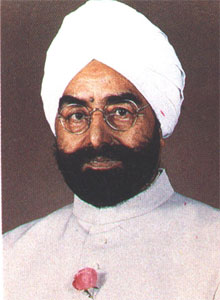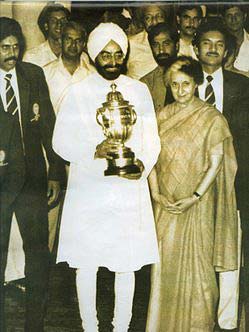<Back to Index>
- Geographer Ferdinand von Richthofen, 1833
- Composer Stanisław Moniuszko, 1819
- 7th President of India Giani Zail Singh, 1916
PAGE SPONSOR


Giani Zail Singh (Punjabi: ਜ਼ੈਲ ਸਿੰਘ, 5 May 1916 – 25 December 1994) was an Indian politician and member of the Congress Party. He served as the seventh President of India. He was the President of India during Operation Blue Star, the assassination of Indira Gandhi, and the 1984 anti-Sikh riots.
Sardar Zail Singh, a Sikh by religion, was given the title of Giani, as he was educated and learned about Guru Granth Sahib at Shaheed Sikh Missionary College in Amritsar. However, he did not have formal secular education. He had a humble start in life and his father was a Sikh Tarkhan Ramgarhia who was killed in an automobile accident.
In
1947, with the reorganization of India along secular lines and the
amalgamation of hundreds of princely states, Giani Zail Singh stood
squarely on the side of democracy and opposed the autocratic Raja
Harindar Singh of Fareedkot. Known
as a bold and honest broker for the people, Zail Singh was called on to
be the Revenue Minister of the newly amalgamated princely states of
Patiala, Jind, Nabha, Kapurthala, Faridkot, Kalsia, Nalagarh and
Malerkotla, designated the Patiala and East Punjab States Union (PEPSU), under Chief Minister Gian Singh Rarevala of Patiala in
1949. In the Congress Government formed on 23 May 1951, he became
Agriculture Minister. From 1956 to 1962, Giani Zail Singh served as a
member of India's upper house of parliament (Rajya Sabha).
The emerging spectre of Sikh separatism in the early 1970s served the Congress Party well and helped to elect Giani Zail Singh as Chief Minister of Punjab in 1972. Voters ran from the traditional Sikh party, the Shiromani Akali Dal. Of a total of 104 seats, the Congress won 66 and their Communist allies 10. Independents took 3, a Marxist 1, and the Akalis just 24. As a lifelong Congress member, Giani Zail Singh still managed to “out-Sikh” the Akalis during his tenure as chief minister. He arranged massive religious gatherings, started public functions with a traditional Sikh prayer, inaugurated a highway named after Guru Gobind Singh, and named a township after the Guru's son.
In the 1980 election, Zail Singh was elected a member of the lower house of the legislature (Lok Sabha),
and picked on January 14 to join Indira Gandhi's cabinet as Minister
for Home Affairs (Security). During his tenure, he is believed to have
worked with Prime Minister Indira Gandhi to promote the personality of Sant Jarnail Singh Bhindranwale at the expense of the Shiromani Akali Dal leadership. With the retirement of Neelam Sanjiva Reddy as President of India,
the members of the Congress Party on 15 July 1982 unanimously nominated
Giani Zail Singh to fill the largely ceremonial office. In the general
vote, he received almost unanimous support, including even the members
of dissident parties such as Shiromani Akali Dal in Punjab (India) and the Communists in Bengal. Nonetheless, some in the media felt that the president had been chosen
for being an Indira loyalist rather than an eminent person. “If my
leader had said I should pick up a broom and be a sweeper, I would have
done that. She chose me to be President,” Singh was quoted to have said after his election. Giani Zail Singh took the oath of office on 25 July 1982. President
Zail Singh served in a largely ceremonial capacity beside the shrewdly
political Prime Minister Gandhi, though protocol dictated that he
should be briefed every week by the prime minister on affairs of state.
The day before the army was sent into Amritsar to attack the holiest
shrine of the Sikhs, the Golden Temple,
Mrs. Gandhi and the president met for more than an hour, but she
omitted even sharing a word about her plan. In the anti-government
sentiment that followed, many Sikhs called on Giani Zail Singh to
resign his post. On advice from Yogi Bhajan that
the situation for Sikhs would only deteriorate if he were to quit, Zail
Singh kept his position. However he was subsequently called before the Akal Takhat to
apologize and explain his inaction at the desecration of the holy site
and killing of innocent Sikhs. At the death of Prime Minister Indira Gandhi, Zail Singh in his role as President appointed her surviving son, Rajiv Gandhi successor. Theirs was an uneasy relationship. Giani Zail Singh served as President of India until 1987.
Whenever Giani Zail Singh was in Punjab or close to it, he rarely missed a chance of paying his respects at the shrine of Anandpur Sahib. On one such pilgrimage, he was involved in a serious auto crash near Kiratpur Sahib in Ropar district
on 29 November 1994. He subsequently died at the Postgraduate Institute
of Medical Sciences in Chandigarh on 25 December 1994 and was cremated
at Ekta Sthal in the Raj Ghat area.